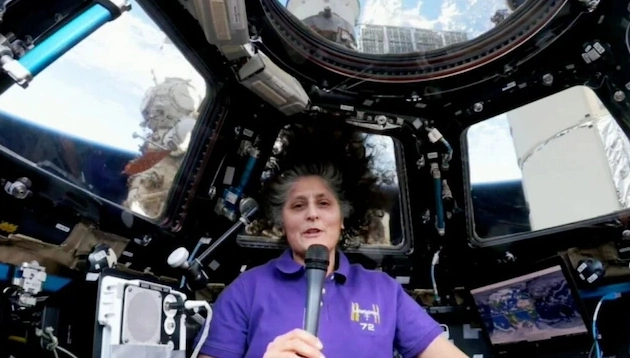
On March 18, 2025, astronauts Sunita Williams and Butch Wilmore safely returned to Earth after an unexpectedly extended nine-month mission in space. Due to technical issues with their spacecraft, their mission on the International Space Station (ISS) was prolonged.
During her extended stay, Sunita Williams faced numerous challenges, including physiological issues such as bone loss, muscle atrophy, and vision changes, as well as the psychological stress of isolation.
Ever wondered what life is really like aboard the International Space Station?
Sunita offers a fascinating glimpse into the daily routines of astronauts in space. In an old video, she demonstrates how astronauts function in microgravity – from eating and sleeping to the unique challenge of using the bathroom. It’s a rare, behind-the-scenes look at life in zero gravity.
Watch the video here.
Without beds and gravity, how is sleeping in space possible?
The sleeping accommodations aboard the International Space Station (ISS) are tiny but useful. Sunita explains: “Four out of six of us sleep here, and people always ask—do you lie down? Are you in bed? Not really, because it doesn’t matter! You don’t have the sensation of lying down. You just get in your sleeping bag."
Every astronaut has a Sleep Station, which is a tiny space resembling a phone booth and furnished with a sleeping bag and personal belongings, including clothes, computers, and books. Because there isn’t a “right side up" like there is on Earth, astronauts can sleep in any position, even upside down.
How do astronauts go to the lavatory?
One of the most frequently asked questions about space travel is how astronauts use the lavatory. Sunita answers this curiosity with a light-hearted yet informative demonstration, shedding light on the challenges of bathroom routines in zero gravity. “For number two, there’s a small seat – you need good aim! And for number one, we use this hose. It’s colour-coded, so we don’t mix things up. And both have suction to make sure everything goes in the right direction!"
As per the video, the ISS toilet uses a vacuum suction technology to stop faeces from floating. Additionally, astronauts have a variety of toilet paper options, ranging from disinfecting towels to Russian wipes. “Toilet paper? We have different options! Russian wipes, tissues, Huggies – just in case – and disinfectant wipes, because, well, things can get out of control!" Williams also says in the video.
How can one brush their teeth in microgravity?
In space, brushing your teeth is a very different experience. Astronauts must be creative because water doesn’t flow the same way it does on Earth. “Toothpaste sticks to the brush, and so does water – it forms a floating bubble because of surface tension. You can either swallow the toothpaste (not recommended at home!) or spit it into a paper towel," Sunita Williams reveals in the clip.
Astronauts use tiny blobs of water that cling to surfaces to rinse their toothbrushes in space, making brushing their teeth a unique challenge in microgravity.
How do astronauts eat in space?
Astronauts eat together in the kitchen. A combination of Japanese, Russian, and American space food is stored aboard the ISS. While some meals can be heated and consumed as usual, others are dehydrated and must be rehydrated with water, the video mentions. In addition, meats, vegetables, snacks, and even candies are among the many meals that astronauts like to eat.
-
Ravi Mohan dating Kenishaa Francis? Friend reacts to her rumoured relationship, says, ‘I’ve known you together…’

-
This actress was abandoned by her father at an orphanage, became third wife of married man, was madly in love with Dharmendra, she was…

-
Sanam Teri Kasam singer Sreerama Chandra reacts to Harshvardhan Rane-Mawra Hocane row: ‘No matter what…’ | Exclusive

-
This company bags Rs 50000000000 projects in Delhi, Andhra Pradesh for…; not Mukesh Ambani’s Reliance, Adani Group, Tata Group, the name is…

-
'See You Soon India': CSK Star Dewald Brevis Sends Exciting Message Ahead Of IPL 2025 Restart
